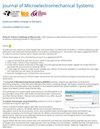3D Flexible Wind Sensor With its Optimization and Environmental Effect
IF 2.5
3区 工程技术
Q2 ENGINEERING, ELECTRICAL & ELECTRONIC
引用次数: 0
Abstract
This paper proposes a new three-dimensional (3D) flexible wind sensor by utilizing dual-layer differential capacitors. The deformation of the sensor caused by wind leads to eight capacitances variation, which can be applied to obtain the wind speed along the x, y, and z axes (vx, vy and vz). Consequently, the 3D wind speed and direction are calculated by the vector synthesis. The feasibility of this measurement principle was verified by simulation. Then, the sensor was fabricated consisting of two windward pillar, four electrode layers, and two supporting layers, which were produced by polydimethylsiloxane (PDMS) with different Young’s modulus. Experiments demonstrated that the sensor can measure 3D wind speed and direction with the dynamic range of 0-23.9m/s. The average errors of wind speed measurement in XY, XZ and YZ planes are close to 0.58 m/s, 0.42 m/s, and 0.53 m/s, respectively, while the average errors of wind direction measurement are about 6.63°, 4.03°, and 5.65° respectively. Furthermore, temperature effect, as well as humidity effect, of the sensor was also investigated. The initial capacitances of the sensor are positively correlated with the temperature and humidity, and the slope are on the order of 6.21fF三维柔性风传感器及其优化和环境效应
本文利用双层差分电容器提出了一种新型三维(3D)柔性风传感器。传感器在风力作用下产生的形变会导致八个电容变化,这些变化可用于获取沿 x、y 和 z 轴的风速(vx、vy 和 vz)。因此,三维风速和风向是通过矢量合成计算出来的。这一测量原理的可行性已通过模拟验证。然后,用不同杨氏模量的聚二甲基硅氧烷(PDMS)制作了由两个迎风支柱、四个电极层和两个支撑层组成的传感器。实验证明,该传感器可测量三维风速和风向,动态范围为 0-23.9 米/秒。风速测量在 XY、XZ 和 YZ 平面上的平均误差分别接近 0.58 m/s、0.42 m/s 和 0.53 m/s,而风向测量的平均误差分别约为 6.63°、4.03° 和 5.65°。此外,还研究了传感器的温度效应和湿度效应。传感器的初始电容与温度和湿度呈正相关,斜率分别为 6.21fF $\cdot ^{\circ }\text{C}^{-1}$ 和 3.21fF $\cdot $ %RH-1。此外,还制作了沟槽以优化传感器的灵敏度,这一点已通过实验得到验证。[2023-0075]
本文章由计算机程序翻译,如有差异,请以英文原文为准。
求助全文
约1分钟内获得全文
求助全文
来源期刊

Journal of Microelectromechanical Systems
工程技术-工程:电子与电气
CiteScore
6.20
自引率
7.40%
发文量
115
审稿时长
7.5 months
期刊介绍:
The topics of interest include, but are not limited to: devices ranging in size from microns to millimeters, IC-compatible fabrication techniques, other fabrication techniques, measurement of micro phenomena, theoretical results, new materials and designs, micro actuators, micro robots, micro batteries, bearings, wear, reliability, electrical interconnections, micro telemanipulation, and standards appropriate to MEMS. Application examples and application oriented devices in fluidics, optics, bio-medical engineering, etc., are also of central interest.
 求助内容:
求助内容: 应助结果提醒方式:
应助结果提醒方式:


